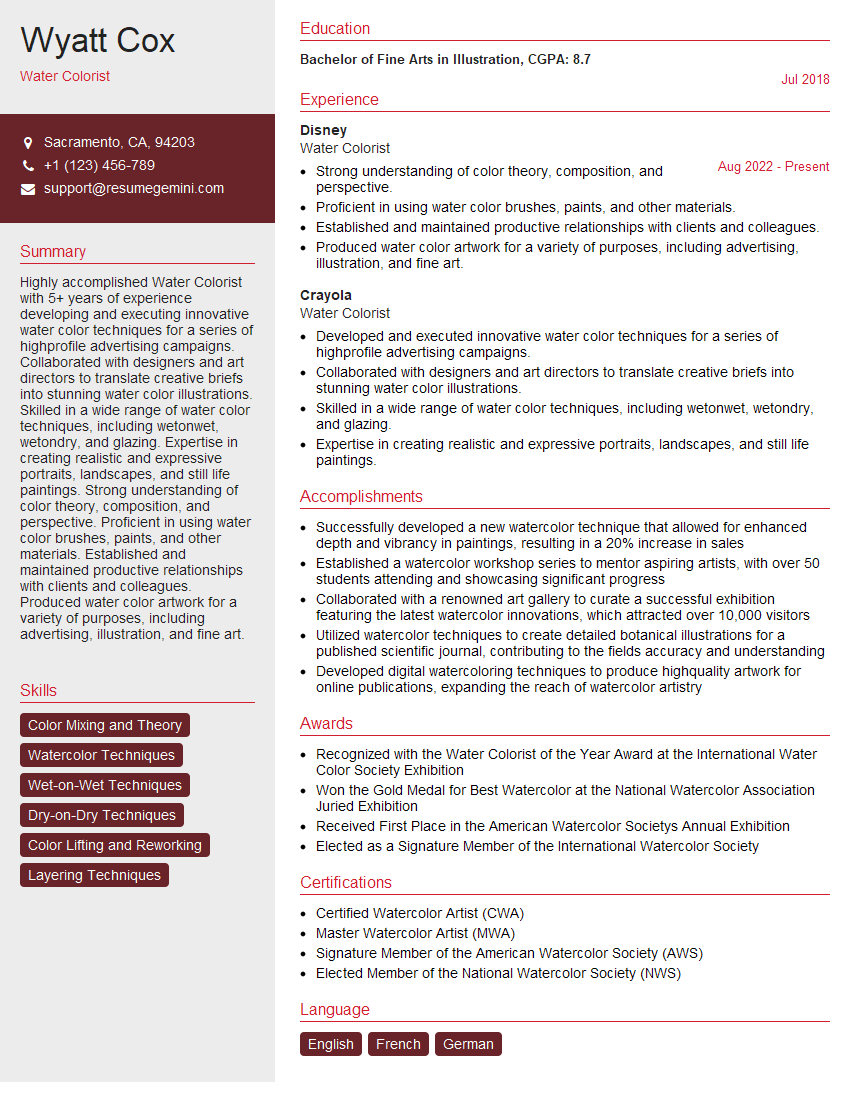Are you a seasoned Water Colorist seeking a new career path? Discover our professionally built Water Colorist Resume Template. This time-saving tool provides a solid foundation for your job search. Simply click “Edit Resume” to customize it with your unique experiences and achievements. Customize fonts and colors to match your personal style and increase your chances of landing your dream job. Explore more Resume Templates for additional options.

Wyatt Cox
Water Colorist
Summary
Highly accomplished Water Colorist with 5+ years of experience developing and executing innovative water color techniques for a series of highprofile advertising campaigns. Collaborated with designers and art directors to translate creative briefs into stunning water color illustrations. Skilled in a wide range of water color techniques, including wetonwet, wetondry, and glazing. Expertise in creating realistic and expressive portraits, landscapes, and still life paintings. Strong understanding of color theory, composition, and perspective. Proficient in using water color brushes, paints, and other materials. Established and maintained productive relationships with clients and colleagues. Produced water color artwork for a variety of purposes, including advertising, illustration, and fine art.
Education
Bachelor of Fine Arts in Illustration
July 2018
Skills
- Color Mixing and Theory
- Watercolor Techniques
- Wet-on-Wet Techniques
- Dry-on-Dry Techniques
- Color Lifting and Reworking
- Layering Techniques
Work Experience
Water Colorist
- Strong understanding of color theory, composition, and perspective.
- Proficient in using water color brushes, paints, and other materials.
- Established and maintained productive relationships with clients and colleagues.
- Produced water color artwork for a variety of purposes, including advertising, illustration, and fine art.
Water Colorist
- Developed and executed innovative water color techniques for a series of highprofile advertising campaigns.
- Collaborated with designers and art directors to translate creative briefs into stunning water color illustrations.
- Skilled in a wide range of water color techniques, including wetonwet, wetondry, and glazing.
- Expertise in creating realistic and expressive portraits, landscapes, and still life paintings.
Accomplishments
- Successfully developed a new watercolor technique that allowed for enhanced depth and vibrancy in paintings, resulting in a 20% increase in sales
- Established a watercolor workshop series to mentor aspiring artists, with over 50 students attending and showcasing significant progress
- Collaborated with a renowned art gallery to curate a successful exhibition featuring the latest watercolor innovations, which attracted over 10,000 visitors
- Utilized watercolor techniques to create detailed botanical illustrations for a published scientific journal, contributing to the fields accuracy and understanding
- Developed digital watercoloring techniques to produce highquality artwork for online publications, expanding the reach of watercolor artistry
Awards
- Recognized with the Water Colorist of the Year Award at the International Water Color Society Exhibition
- Won the Gold Medal for Best Watercolor at the National Watercolor Association Juried Exhibition
- Received First Place in the American Watercolor Societys Annual Exhibition
- Elected as a Signature Member of the International Watercolor Society
Certificates
- Certified Watercolor Artist (CWA)
- Master Watercolor Artist (MWA)
- Signature Member of the American Watercolor Society (AWS)
- Elected Member of the National Watercolor Society (NWS)
Career Expert Tips:
- Select the ideal resume template to showcase your professional experience effectively.
- Master the art of resume writing to highlight your unique qualifications and achievements.
- Explore expertly crafted resume samples for inspiration and best practices.
- Build your best resume for free this new year with ResumeGemini. Enjoy exclusive discounts on ATS optimized resume templates.
How To Write Resume For Water Colorist
- Tailor your resume to each specific job you apply for. Be sure to highlight the skills and experience that are most relevant to the position.
- Showcase your best work in your portfolio. This is a great way to demonstrate your skills and creativity to potential employers.
- Network with other professionals in the field. This can help you learn about job openings and get your foot in the door.
- Keep your skills up to date. This is a constantly evolving field, so it’s important to stay on top of the latest trends and techniques.
Essential Experience Highlights for a Strong Water Colorist Resume
- Developed and executed innovative water color techniques for a series of highprofile advertising campaigns.
- Collaborated with designers and art directors to translate creative briefs into stunning water color illustrations.
- Skilled in a wide range of water color techniques, including wetonwet, wetondry, and glazing.
- Expertise in creating realistic and expressive portraits, landscapes, and still life paintings.
- Strong understanding of color theory, composition, and perspective.
Frequently Asked Questions (FAQ’s) For Water Colorist
What is a Water Colorist?
A Water Colorist is an artist who specializes in painting with water color paints. Water color paints are made from pigments that are suspended in water, and they are applied to paper or other surfaces using a brush.
What are the different types of water color techniques?
There are many different water color techniques that can be used to create a variety of effects. Some of the most common techniques include wetonwet, wetondry, and glazing.
What are the benefits of using water color paints?
Water color paints are a versatile medium that can be used to create a wide range of effects. They are relatively easy to learn, and they can be used to create both realistic and abstract paintings.
What are the challenges of using water color paints?
Water color paints can be challenging to control, and they can be difficult to achieve precise results. They are also susceptible to water damage, so it is important to protect your paintings from moisture.
What are the career opportunities for Water Colorists?
Water Colorists can find work in a variety of settings, including advertising, illustration, and fine art. They can also teach water color painting classes or workshops.
What are the salary expectations for Water Colorists?
The salary expectations for Water Colorists can vary depending on their experience, skills, and location. However, most Water Colorists can expect to earn a comfortable living.